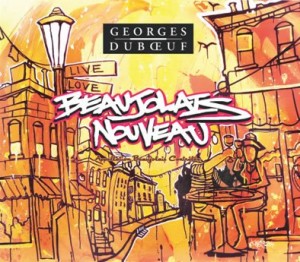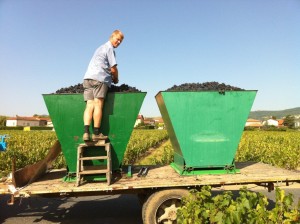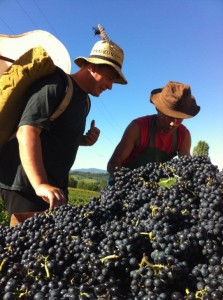Out with the old, in with the Nouv.
Yesterday, I watched break-dancers spin on their heads and contort their skinny bodies into bendy, twisty positions to the thump-thump of some seriously throw-back early 80s hip-hop. I wasn’t catching an impromptu street-dance session, or even the subway car performance I sometimes have a first-row view of in the narrow, space-defying confines of the downtown A train (caught a sneaker in the face once with that—oof).  Where I happened to be yesterday was an event space in Midtown Manhattan, and the occasion was the release of the 2011 Beaujolais Nouveau from the famed producer George Duboeuf. Holla! (Or, as we used to say back in the 80s, woooooord.)
Where I happened to be yesterday was an event space in Midtown Manhattan, and the occasion was the release of the 2011 Beaujolais Nouveau from the famed producer George Duboeuf. Holla! (Or, as we used to say back in the 80s, woooooord.)
Happy Nouveau Year
It is that time of year, after all, and I don’t mean Thanksgiving. If you’re not familiar with the vinous tradition, bouncy, bright bottles of Beaujolais Nouveau are released on the third Thursday of every November, upstaging Turkey Day with giddy cork-popping the world ‘round. But what is it? Pretty much exactly what it sounds like – new wine, which is made from the Gamay grape in the Beaujolais appellation of southern Burgundy. Usually, the grapes aren’t the better clusters that may be picked for Beaujolais or Beaujolais Village, or the super-duper top quality certainly picked for the elegant Cru Beaujolais—the latter often cited as the perfect Thanksgiving wine and lauded for its depth and expressiveness.
But that’s not what Nouveau is. Nouveau is made for drinking, and drinking fast. It’s bottled within a couple of months of harvest. Normally with your average bottle of wine, grapes are crushed, yeast is added during fermentation (e.g., when yeast turns the sugar in the grapes to alcohol), and, in the case of red wine, all that crushing and fermenting and macerating happens with the skins in the mix. Skins add color and that puckery, mouth-drying stuff called tannins. Tannins add structure; tannins help a wine to age in comely manner. But that ain’t Nouveau.
Nouveau undergoes a funny procedure called carbonic maceration, a winemaking method imparted to keep things light and loopy. Whole, uncrushed clusters of the just-picked Gamay grapes go into a vat and are sealed under a layer of carbon dioxide. Left to their own individual devices with no yeast added, the little grapes start fermenting all by their lonesome inside their own skins, until they burst open, finish fermenting, and voilá—you’ve got a wine that’s had very little mosh-pit skin contact, and so isn’t so very tannic. It tastes super fresh, fruity, and, well… new.
The whole point of its invention was to celebrate the harvest. And then it kind of took on a life of its own. In 1960, 10,000 cases of Beaujolais Nouveau were exported from France, said Franck Duboeuf yesterday, son of Georges, when he popped open the inaugural 2011 bottle after the break-dancers had finished their spinning and stepping. Within a decade, that number would increase to a million. By 1985, the genius marketing ploy of setting 12:01 a.m. of the third Thursday of the November as the official Nouveau release was enacted by the Institut National des Appellations d’Origine. And so the frenzy began.
Tannins add structure; tannins help a wine to age in comely manner. But that ain’t Nouveau.
Hot or Hype?
Duboeuf is probably the most commercially and broadly famous of the Beaujolais producers, and certainly the most well-known for his splashy releases of the Nouveau. But among some wine circles, the producer gets a few eye-rolls for the Nouveau antics and what some believe to be an over-manipulated, over-marketed 750 milliliter bottle of hype. I came home from the lunch to myriad Nouveau grumblings and a minor rant from a fellow wine writer, who I like and respect, on Facebook: “It never ceases to amaze me how many wine people — many worthy of respect and admiration — lose their minds today for Beaujolais Nouveau. I don’t know if it’s the samples, the freebie lunches or what. It’s not good wine. You lose credibility with smart people.”

And I understood his rant. I mean, as I drifted around the room during lunch, there were a few people around me debating the Nouveau’s merits and comparing it to the vintage before—which, you know, seemed kind of silly; kind of like comparing the quality of last year’s Halloween candy corn to this. It’s Nouveau! Its merit is that it’s ripe and fruity and festive. But along the same lines, I also thought that my colleague’s rant was a little bit harsh. When Easter comes around, I love to eat Peeps. When Halloween hits the calendar, my hand dives into that bowl of candy corn. Is it great? No. But yes! It’s candy corn! And it’s fun. And that’s the whole point. No one really ponders Beaujolais Nouveau. How can you? You shouldn’t even be drinking it much past a month or so after it comes out. (Although once I walked into a local liquor store and on display was a box of last year’s Duboeuf; I never went back there again.) It’s not Village and it’s not Cru; it is simple and fun and fresh and grapey. And that’s what it’s supposed to be.
Label Conscious
This year’s label was created by a Brooklyn-based graffiti artist named Caves.  The scene he depicts looks like a Paris street café reimagined all mashed up with New York City circa the mid-80s, with the words “Beaujolais Nouveau” written as though tagged on the side of subway car with a can of white spray paint—a fleeting moment grasping at immortality. It’s maybe the coolest label I’ve seen on a bottle of Nouveau; it perfectly encapsulates what the wine is supposed to be all about.
The scene he depicts looks like a Paris street café reimagined all mashed up with New York City circa the mid-80s, with the words “Beaujolais Nouveau” written as though tagged on the side of subway car with a can of white spray paint—a fleeting moment grasping at immortality. It’s maybe the coolest label I’ve seen on a bottle of Nouveau; it perfectly encapsulates what the wine is supposed to be all about.
“It’s a fast, short-lived wine,” said Caves, when he took the stage in a black pork-pie fedora and sunglasses. “… and life goes by real fast, too.”

Hey, saw this here in New Haven and wanted to get some, completely ignorant to the backstory. I was attracted to the label. Beautiful job. Hope to still buy some.
Found two bottles left of this at Old Bins in New Haven tonight. I love it. So does my roommate. Gorgeous label, too.
I just had a bad experience with BN last night, should it have gone bad already? I like many red wines including Village and Cru Beaujolais, but this stuff tasted awful. Maybe from a bad batch, or is it supposed to be like this by January?
Hey AMiller — well, let’s start with this: try to describe to me what/how it tasted bad. What it oxidized? Astringent? Nouveau should be, first and foremost, full of bright, upfront fruit. Some have more of a linear, Cru Beauj feel to them (I thought Kermit Lynch’s this hear had a lot of lovely minerality — really nice Nouveau!), and it’s always possible that this is a style that the drinker just doesn’t dig, but it sounds like you do — so, give me some deets! And maybe I can help. AZ